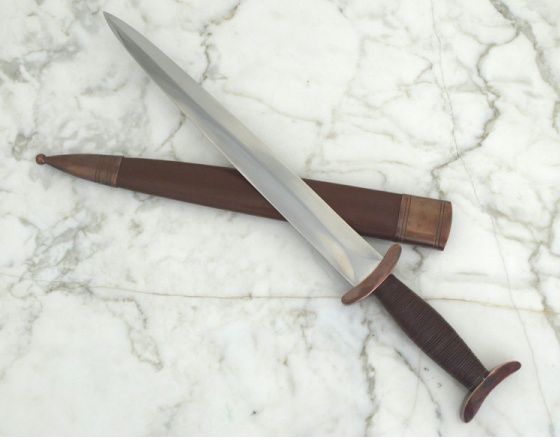| Author |
Message |
Jasper B.

|
 Posted: Thu 06 Aug, 2015 3:08 am Post subject: What type of dagger is this? Posted: Thu 06 Aug, 2015 3:08 am Post subject: What type of dagger is this? |
 |
|
What type of dagger is this?

I originally thought that this is a Holbein dagger, but looking at examples of Holbein daggers leads me to believe that it is not.
Does anyone know what type of dagger it is? Where was it used? in what age?
Regards,
J.B.[/img]
 Attachment: 57.94 KB Attachment: 57.94 KB

|
|
  |
 |
|
Mark Griffin
Location: The Welsh Marches, in the hills above Newtown, Powys. Joined: 28 Dec 2006
Posts: 802
|
 Posted: Thu 06 Aug, 2015 4:04 am Post subject: Posted: Thu 06 Aug, 2015 4:04 am Post subject: |
 |
|
it kind of falls into the 'baselard' category, so its a bit earlier than the Swiss/Holbein style.
Currently working on projects ranging from Elizabethan pageants to a WW1 Tank, Victorian fairgrounds 1066 events and more. Oh and we joust loads!.. We run over 250 events for English Heritage each year plus many others for Historic Royal Palaces, Historic Scotland, the National Trust and more. If you live in the UK and are interested in working for us just drop us a line with a cv.
|
|
  |
 |
|
Tim Jones
Location: United Kingdom Joined: 05 Nov 2013
Posts: 37
|
 Posted: Thu 06 Aug, 2015 1:18 pm Post subject: Posted: Thu 06 Aug, 2015 1:18 pm Post subject: |
 |
|
|
From what I can remember there's quite a few of them in 13th century art. I can vaguely remember something about a specific term, but I'm probably mistaken.
|
|
  |
 |
Gábor Benko

Location: Hungary Joined: 08 Feb 2015
Posts: 20
|
 Posted: Thu 06 Aug, 2015 3:22 pm Post subject: Posted: Thu 06 Aug, 2015 3:22 pm Post subject: |
 |
|
It reminds me a little bit to a dagger type, which was popular in the XIVth century Hungarian Kingdom.
 
The dagger type-s name in the sources is "bicellus"
"Usque ad finem"
|
|
  |
 |
|
William P
|
 Posted: Fri 07 Aug, 2015 6:47 am Post subject: Posted: Fri 07 Aug, 2015 6:47 am Post subject: |
 |
|
| Gábor Benko wrote: | It reminds me a little bit to a dagger type, which was popular in the XIVth century Hungarian Kingdom.
 
The dagger type-s name in the sources is "bicellus" |
that explains the source fir this dagger in mount and blade: warband vignette2.wikia.nocookie.net/mountandblade/images/5/5f/Dagger_(Warband).png/revision/latest?cb=20120311145653
|
|
   |
 |
Jasper B.

|
 Posted: Sun 09 Aug, 2015 5:31 am Post subject: Posted: Sun 09 Aug, 2015 5:31 am Post subject: |
 |
|
| Tim Jones wrote: | | From what I can remember there's quite a few of them in 13th century art. I can vaguely remember something about a specific term, but I'm probably mistaken. |
That is very interesting. So it is not a baselard (I can see stylistic similarities but also notable differences)? But instead it is a dagger type from the 13th century? What region is the art you describe from?
J.B.
|
|
  |
 |
J. Nicolaysen

|
 Posted: Sun 09 Aug, 2015 1:31 pm Post subject: Posted: Sun 09 Aug, 2015 1:31 pm Post subject: |
 |
|
| Quote: | | So it is not a baselard (I can see stylistic similarities but also notable differences)? But instead it is a dagger type from the 13th century? What region is the art you describe from? |
No, Baselard is probably the best term.
The terms Baselard, Holbein and Swiss dagger are not exactly as specific as you might like. They can describe a dagger from a specific area such as Basl, Switzerland, or one with Holbeinesque designs on the scabbard, or something that just looks like one of these but may come from a different place altogether. Without some more information on the original picture, I don't know if anyone can give you a very specific answer. It's a popular shape and style and was used in different areas and times because of its comfortable grip and usefulness. You might as well call it a baselard since it has the characteristic "I" or "H" shaped guard. http://myArmoury.com/talk/viewtopic.php?t=165...d+basilard Some people could guess the hilt shape comes from the Basl examples but others might trace it back to the anthropomorphic hilts of bronze or early iron age. I think it is more of a case of good design crops up across the centuries.
There is also the Aunlaz dagger. A&A makes one from the Royal Armouries, the original which looks very similar to the Hungarian bicellus above. In fact, I would think it is the same picture without more information about the Hungarian example. http://www.myArmoury.com/review_aa_aunlaz.html
However, Aunlaz is not a specific term either. I remember a reference to it in one of Oakeshott's books, probably Archaeology of Weapons, but I can't find my copy right now. As I recall this single reference didn't have anything to mention of the Baselard type!
Anyhow the I shaped hilt and the thicker cutting/stabbing style blade rather than a piercing blade of many Ballock daggers would just have me call it a Baselard and start researching there. https://en.wikipedia.org/wiki/Baselard and manuscript miniatures of course. The general time period of 13 and 14 century is about right since later, other dagger forms became more popular. As for area, it could be anywhere across western and central Europe I think.
Some people write Basilard too.
|
|
  |
 |
|
|

